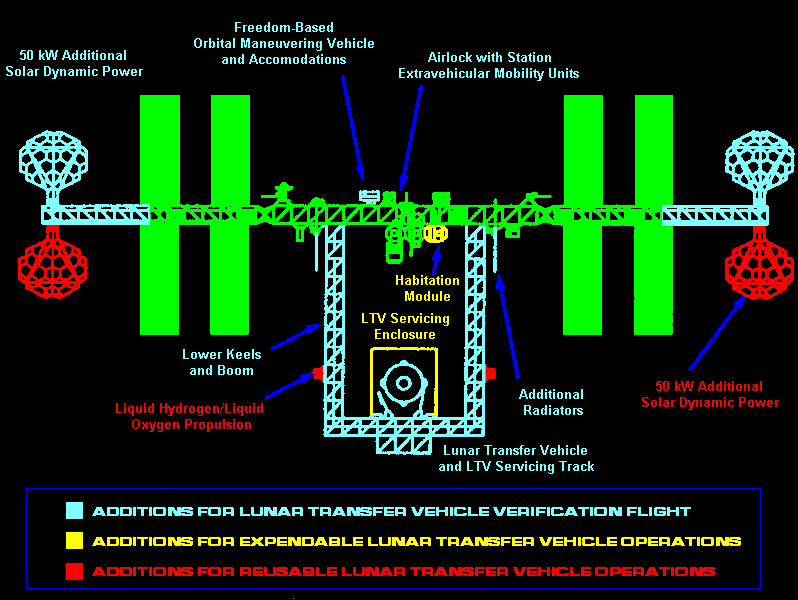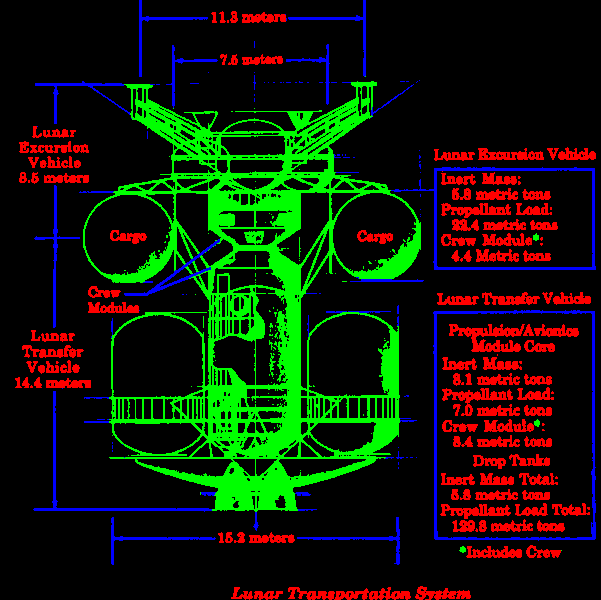

|
.
"First, for the coming decade, for the 1990s, Space Station Freedom, our critical next step in all our space endeavors. And next, for the next century, back to the Moon, back to the future, and this time, back to stay. And then a journey into tomorrow, a journey to another planet, a manned mission to Mars..." -- President George Bush, July 21st 1989 |
||||||||||||||||||||||||||||||||||||||||||||||||||||||||||||||||||||||||||||||||||||||||||||||||||||||
|
With these words, President Bush directed NASA to start planning
for ambitious new missions to the Moon and Mars. Vice President Dan Quayle
and National Space Council director Mark Albrecht had been formulating
the project in secret since June. This angered officials in the Office
of Management and Budget, who complained about being kept in the dark and
regarded the SEI as totally unrealistic since it would require a doubling
of NASA's budget over the next ten years. Congress concurred since it had
recently passed the Gramm-Rudman-Hollins deficit reduction act. There was
no money in the federal budget for expensive new space endeavors. Nonetheless,
NASA was asked to report back to the President's Space Council on how to
implement the plan. The resulting "90-Day Study" prepared by a NASA/Johnson
Space Center team led by JSC Director Aaron Cohen contained five alternatives
but no specific recommendations. The five "reference approaches" had slightly
different priorities: (A) balance and speed, (B) the earliest possible
landing on Mars, (C) reduced logistics from Earth /in-situ resource utilization,
(D) schedule adapted to Space Station Freedom, and (E) reduced scale. The
timetable was as follows:
|
||||||||||||||||||||||||||||||||||||||||||||||||||||||||||||||||||||||||||||||||||||||||||||||||||||||
 NASA would have spent $500 million in 1992-96 on resource surveys from unmanned lunar mapping satellites. A number of robotic rovers and sample return probes capable of returning 3kg samples to Earth would then have been sent to candidate sites for the moonbase. |
||||||||||||||||||||||||||||||||||||||||||||||||||||||||||||||||||||||||||||||||||||||||||||||||||||||
Meanwhile, NASA would be busy preparing the recently completed Space Station Freedom for its expanded role as a spaceport for manned lunar missions. The 60 x 35-meter "Dual Keel" beam structure that was postponed indefinitely in 1987-88 would have to be built after all -- initially to support flights of expendable moonbase cargo transfer vehicles. It would contain a hangar / servicing facility for reusable Lunar Transfer Vehicle "space tugs" (LTVs) and would cost at least $188 million. Two 75KW solar dynamic power generators would have to be added at a cost of at least $712 million. The additional power is required for the LTV facility and to support an enlarged crew of 14-16 astronauts temporarily for lunar missions. NASA identified four separate upgrades to Freedom that gradually would have increased its capabilities by adding more habitation modules, power, space vehicle processing facilities and crewmembers. The Space Station would support two lunar missions per year in 1999-2002 but there will be no Lunar Transfer Vehicle refurbishment capabilities at this point so all missions would have to be expendable. Additional solar-dynamic power generators and other equipment would permit LTV servicing in 2003- and Freedom would support up to three lunar missions per year beginning in 2004. |
||||||||||||||||||||||||||||||||||||||||||||||||||||||||||||||||||||||||||||||||||||||||||||||||||||||

|
||||||||||||||||||||||||||||||||||||||||||||||||||||||||||||||||||||||||||||||||||||||||||||||||||||||
SHUTTLE-C. The Space Shuttle would transport lunar crews and cargo to Space Station Freedom, where they would be transferred to Lunar Transfer/Excursion Vehicles. The LTV,LEV and the propellant to land them on the Moon would meanwhile have been delivered to Freedom by Shuttle-derived unmanned heavy lift rockets. Three "Shuttle-C" launches would initially be required per lunar landing -- one for the spacecraft and two for the fuel. Each flight would deliver a net payload of 61-71 metric tons to the Space Station, and approximately 75% of the total mass delivered would be rocket propellant. Two different Shuttle-C versions would be required. The standard version depicted here would have a 25 x 4.6m cargo bay and could deliver compact 71-tonne payloads (mainly propellant tanks) to Freedom. The other version would have a 7.6-meter diameter payload shroud for launching large-diameter Lunar Excursion Vehicle and aerobrake elements. Its payload capability would only be 61 metric tons, and it would require some modifications to the Shuttle launch & payload processing facilities as well. The total cost of developing Shuttle-C would be $5.3 billion, including production of an initial batch of five vehicles. Some of these would be used to launch the final pieces of Space Station Freedom in 1996-97. This would have permitted NASA to end the Phase 1 Freedom construction work more quickly than if the considerably less powerful standard Space Shuttle were used. |
||||||||||||||||||||||||||||||||||||||||||||||||||||||||||||||||||||||||||||||||||||||||||||||||||||||
A Lunar Transfer Vehicle (LTV) jettisons two propellant tanks after leaving Earth orbit. Formerly known as the Orbital Transfer Vehicle, NASA renamed the vehicle in 1988 to stress its importance for manned lunar base missions. The LTV baseline was based on design work by Boeing who received a $2.5-million 18 month Phase A study contract in June 1989. NASA also awarded a similar contract to Martin Marietta. Boeing's LTV would provide transportation between Space Station Freedom and lunar orbit. The oxygen & hydrogen propellant (129.8t in all) would be stored in four 1.45-tonne expendable fuel tanks. The empty tanks would be discarded in Earth and lunar orbit to reduce the mass of the vehicle; 10% more fuel would have to be carried if the tanks have to be returned to Earth orbit for reuse. The basic, reusable LTV weighs 8.1t empty and consists of a propulsion/propellant/avionics module that holds 7t of propellant for returning to SS Freedom from lunar orbit. A large aerobrake protects the vehicle as it performs an "aerocapture maneuver" to kill off excess speed by passing through the Earth's upper atmosphere. This will save rocket propellant but the aerobrake will be heated to more than 1000K so it is made of advanced thermal protection materials. Aerobrake reuse for five missions is assumed, with refurbishment and verification at SS Freedom. The LTV would transport a crew of four astronauts in an 8.4-tonne passenger module as well as up to 22.4t of cargo in two external containers. Propulsion is provided by four 89 kilonewton-thrust rocket engines (481s Isp). |
||||||||||||||||||||||||||||||||||||||||||||||||||||||||||||||||||||||||||||||||||||||||||||||||||||||

|
||||||||||||||||||||||||||||||||||||||||||||||||||||||||||||||||||||||||||||||||||||||||||||||||||||||
Lunar Excursion Vehicle (right) rendezvous with LTV in lunar orbit. The second component of the lunar transportation system was the LEV, which would transport crews and cargo between lunar orbit and the lunar surface. It would land up to 33t of cargo in an expendable mode (=use all propellant for descent) or 13-15t plus a 4.4-tonne crew module for four astronauts in a piloted mode. Most LEV systems (e.g. main engines, attitude control system, avionics, communications) would be similar to the LTV's. The vehicle weighs 5.8t empty; 22.4t fully fueled. It can be stored for up to 30 days on the lunar surface or in lunar orbit. The LEV is powered by four 89 kilonewton-thrust rocket engines (465s Isp). |
||||||||||||||||||||||||||||||||||||||||||||||||||||||||||||||||||||||||||||||||||||||||||||||||||||||
Lunar Excursion Vehicle lands on the Moon with payload. Emplacement of the lunar outpost would begin with an unmanned test flight to deliver a small unpressurized rover + equipment necessary to prepare the outpost site and off-load future moonbase payloads. The rover would initially be operated telerobotically from Earth and later be used to transport astronauts over short distances (less than 50km) on the lunar surface. The second unmanned flight would deliver a permanent habitat derived from SS Freedom's habitation module, an airlock, power & thermal control systems and associated support equipment. |
||||||||||||||||||||||||||||||||||||||||||||||||||||||||||||||||||||||||||||||||||||||||||||||||||||||
SOURCES:
NASA/Johnson Space Center [November 1989] |
||||||||||||||||||||||||||||||||||||||||||||||||||||||||||||||||||||||||||||||||||||||||||||||||||||||
| FAIR USE NOTICE: This page contains copyrighted material the use of which has not been specifically authorized by the copyright owner. Pegasus Research Consortium distributes this material without profit to those who have expressed a prior interest in receiving the included information for research and educational purposes. We believe this constitutes a fair use of any such copyrighted material as provided for in 17 U.S.C § 107. If you wish to use copyrighted material from this site for purposes of your own that go beyond fair use, you must obtain permission from the copyright owner. | ||||||||||||||||||||||||||||||||||||||||||||||||||||||||||||||||||||||||||||||||||||||||||||||||||||||
| ~ MENU ~ |

Webpages © 2001-2016 Blue Knight Productions |